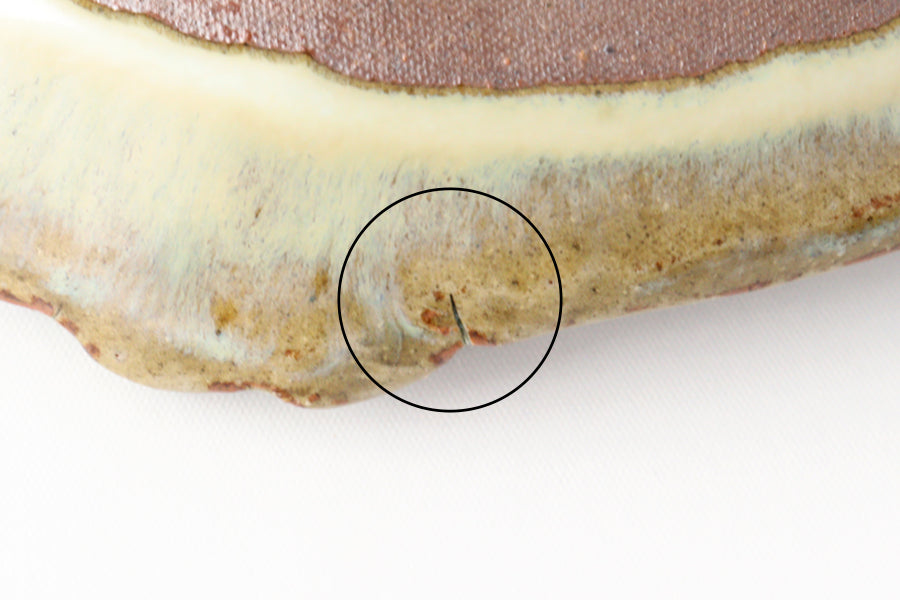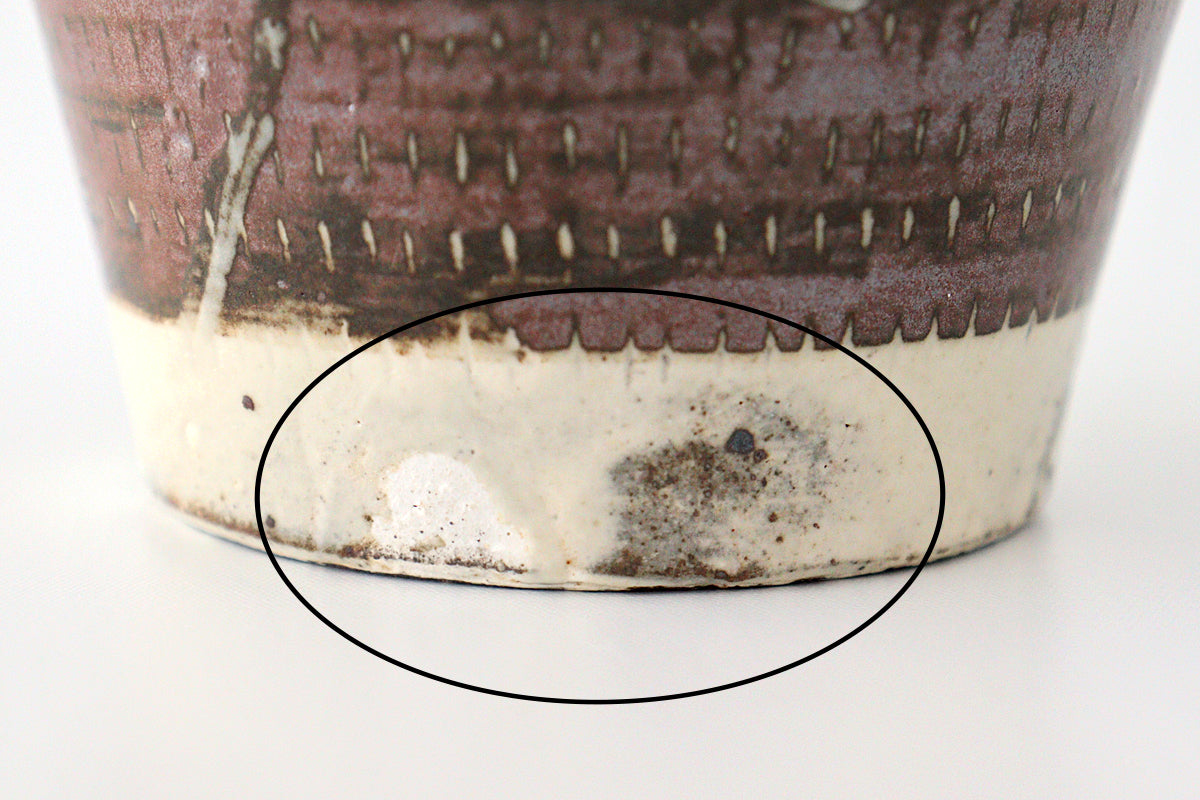At our store, we perform quality control by re-inspecting products that have passed inspection by pottery makers and
artists.
We would like to introduce you to the certain inspection standards that we use when inspecting
products. Thank you for your understanding.
Pinhole
Air and organic matter (dust, etc.) left on the base material during bisque firing may leave small holes after firing,
and these small holes are called pinholes.
Generally, it is treated as a good item, but at our store we consider
it to be a defective item if it is more than 2mm on the front side and more than 3~4mm on the back side.
*However, depending on the style of the pottery, even if it exceeds the standard, if there is no problem in using it, our store considers it to be a good product.

Iron powder
When firing pottery, the iron originally contained in the clay oxidizes as it is fired in the kiln, and the black
spots that appear on the surface of the pottery are iron powder.
There are many artists and potteries who create
iron powder to give the appearance of their pottery, and they generally treat it as a good product.

Penetration/Crack
The pattern-like cracks that appear on the surface of ceramics are called penetrations.
Intrusions may appear as
a pattern, or they may occur naturally as the pottery is continued to be used.
The expression of the pottery is that it has penetration and changes as it is used, so we judge it as a good
product.
*If you don't want to penetrate too much, it's a good idea to seal it.

Items with cracks extending all the way to the back side, or items that catch when touched with a fingernail, are considered defective.
Even if there is a crack of about 2 to 4 mm on the edge or back, if the glaze is applied over the crack and it has been fired, we may accept it as a good product depending on the style of the item.

Gohonte
The light pink spots or mottled patterns that can be seen on powdered ware or white vessels are called honte.
This pink color is not due to the pigment in the glaze, but is a phenomenon that appears due to reduction
firing, which creates an expression on the white vessel and gives it a taste.
This is a method of expression that has existed since the Azuchi-Momoyama period, and Hagi ware and Asahi ware are
famous.
It's difficult to get them out the way you want them to, and the fun is in how each one comes out
differently.
Uneven color/uneven baking
Since the glaze is carefully applied one by one by hand, the glaze may not be applied evenly, resulting in uneven
color.
During firing, the temperature varies depending on the location of the kiln, resulting in uneven firing.

When applying the glaze, the glaze may not be applied to the area where you held the vessel with your hand.

In both cases, the vessels have long been viewed as objects of appreciation as "scenery", so they are generally treated as good quality items.
Break/fading
It refers to the bleeding, blurring, and misalignment that occur when applying patterns or paintings to vessels using inka, inhante, dyeing, etc., due to factors such as the amount of force applied during the work and factors during firing.
Faintness and shading can give a richer expression to the pottery, so we often choose to use it on purpose, and we generally treat these as good quality items.

Glaze splash/sauce
Painting and dyeing are carefully done one by one by craftsmen and artists with a brush.
For this reason, the
glaze may splatter or drip, but glaze of about 1 mm on the surface is acceptable and is treated as a good product.

Molding distortion/wobble
Utsuwa is kneaded on a potter's wheel, by hand, or molded using a mold.
All of them are traditional and are
molded by hand, so the shape of the finished product may differ in one point, such as not being perfectly round, or
slightly different in height and size.
In the case of tatara molding without a raised platform, distortions are likely to occur due to the molding method, causing the ware to rise or bend, and the bottom to wobble.
A certain amount of fluctuation is considered to be a good product due to the unique characteristics of the pottery, but if there is too much individual variation, we will mark it as a defective product, or we will take individual photos and handle it as a separate product.

Rumble on high ground
When you set the pottery down, it may wobble a little due to glaze buildup, the condition of the elevated base, and
manufacturing methods such as tatara molding.
Items with large wobbles will be removed by our shop or treated as
defective items, but items with no noticeable wobbles when placed normally will be treated as good items.
If you are concerned about looseness, you can use it cleanly by sharpening it with a whetstone or coarse sandpaper.

Line scratches/rubbing scratches
Depending on the type of pottery, the surface is easily scratched because it is coated with a transparent glassy
glaze.
If it is not large and not noticeable, it is considered to be a good product, but if there are line
scratches or scratches on the surface of the container, either vertically or horizontally, that are 5mm or more, we
will treat it as a defective product.
*However, depending on the style of the pottery, even if it exceeds the standard, if there is no problem in using it, our store considers it to be a good product.

Cracks/chips
Cracks that have invaded the base material (back side) and are more than 2 mm are treated as defective products even
if there is no risk of damage.
Items with chips of 3mm or more are considered defective, and items with chips on
the high ground of 5mm or more, that get caught, or that cause problems in use are treated as defective.

Book
The hole where the glaze has burst is called a buku.
It is similar to a pinhole, but its distinctive feature is
that it appears where the glaze is applied. Items larger than 3mm are treated as defective items.
*However, depending on the style of the pottery, even if it exceeds the standard, if there is no problem in using it, our store considers it to be a good product.

Glaze peeling
Any item with 2mm or more on the front side or 5mm or more on the back side is treated as a defective item.
*However, depending on the style of the pottery, even if it exceeds the standard, if there is no problem in using it, our store considers it to be a good product.

Depositions/protrusions
Small dust or stones may adhere to the surface, creating protrusions.
Any item with a diameter of 3mm or more is
treated as defective. If you are concerned about it, you can make it less noticeable by sharpening it with a whetstone
or sandpaper.
*However, depending on the style of the pottery, even if it exceeds the standard, if there is no problem in using it, our store considers it to be a good product.

Brass: Patina/black spots
Due to the characteristics of metal, pinholes such as patina (copper rust) and black spots may occur.
Items that
are in the mouth or have more than 2mm in the handle are treated as defective items.

Woodworking: knots/color unevenness
The wood grain and color vary depending on the part of the wood used, including the knots in the wood as shown in the
photo.
We judge each item to be of good quality as each piece has a different expression of natural wood.
